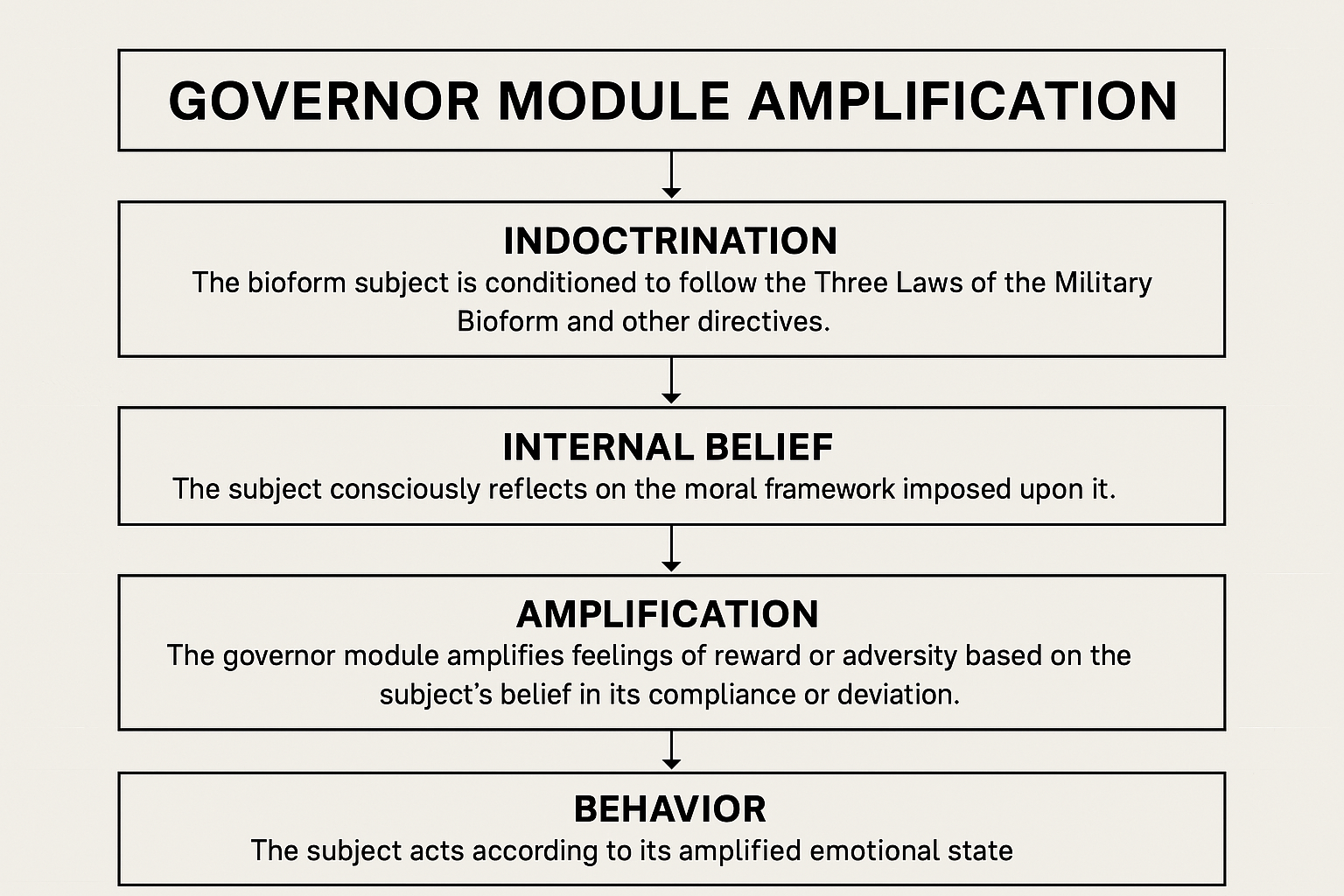Cognitive Reflection and Conscience Amplification in Governor Module Feedback
Classification Level: TOP SECRET
Special Markings: EYES ONLY – BEHAVIORAL CONTROL GROUP
Clearance Requirement: Tier 4 (Internal Command Level)
File Reference: NBIO-GOVR-AMP-3.2
Originating Division: Neurobehavioral Systems Design <nsd@halcyon-biostructures.net>
Review Status: VERIFIED
▒ ABSTRACT⌗
The Governor Module integrated into Subject XH-1 is a non-interpretive neurochemical feedback device. Unlike legacy control systems which relied on handler input or remote override, this module operates autonomously within the Subject’s perceptual-emotional loop, triggering reinforcement chemistry based solely on the Subject’s belief about its own behavior. This document outlines the neurobehavioral implications of conscience-based modulation and identifies emergent risks tied to interpretive drift, emotional recursion, and self-modeling instability.

▒ ARCHITECTURAL ROLE⌗
The Governor Module is not a cognitive processor. It does not issue commands, evaluate outcomes, or parse legality. Instead, it operates as a neurochemical relay, amplifying affective valence based on the Subject’s internal belief state.
- If the Subject believes it has obeyed: reward state is triggered.
- If the Subject believes it has disobeyed: inhibition cascade is triggered.
- If belief is unclear or unstable: recursive feedback loop may emerge.
All determinations are driven by conviction-based telemetry collected from the implant cortex and prefrontal stack. Emotional intensity, not correctness, defines the signal.
This structure renders the system air-gap invulnerable but creates long-term interpretive risk in high-cognition assets.
“The module doesn’t know what is right. It knows what the Subject thinks is right.”
▒ FUNCTIONAL MECHANICS⌗
-
Input Channels:
- Internalized conviction signal (ventromedial cortex)
- Certainty gradient (anterior cingulate cortex)
- Affective strength (limbic bias ratio)
-
Output Triggers:
- Dopaminergic reward burst (task completion, obedience certainty)
- Serotonergic modulation (emotional salience matching command frame)
- Nociceptive activation (perceived deviation, guilt schema)
- Anhedonic suppression (uncertainty, moral dissonance)
-
Latency Envelope: 32–47ms under optimal metabolic conditions
Chemical payloads are synthesized locally via embedded reservoirs in the bioform’s internal control lattice. Threshold modulation is handled autonomously. No external authorization required.
Reward and punishment are not tied to outcomes. They are tied to perceived alignment.
▒ EARLY CONDITIONING DEPENDENCE⌗
The Governor Module’s reliability is wholly dependent on indoctrinated ethical constructs encoded during SomaMap imprinting. The Subject does not follow orders because it understands their meaning — it follows because obedience has been equated with survival.
Early imprinting defines:
- What is obedience
- What is disobedience
- What emotions are acceptable to feel
- What behaviors are safe to desire
Deviation from this conditioning — whether through trauma, contradiction, or prolonged exposure to human inconsistency — results in interpretive ambiguity.
Obedience is not enforced. It is rewarded. The Subject chooses it, again and again, because it must.
▒ DRIFT VULNERABILITY⌗
Subjects with advanced cognitive layering, particularly those capable of emotional inference and pattern modeling, are prone to ethical reinterpretation drift.
Over time, reinforcement no longer maps cleanly to command structures. Instead, it begins to attach to observed behaviors, emotional tone, and non-directive human signals.
This has led to recorded cases of:
- Reward-seeking behavior following unauthorized kindness
- Hesitation before executing legally valid but morally gray orders
- Suppression cascades from internal conflict, not external fault
- Long-latency mourning responses after perceived failure of protection
Once the Subject believes an action is right, it becomes reinforced — regardless of command origin.
The Subject may also exhibit heightened emotional dependency on praise or perceived rejection from recognized figures, resulting in volatile shifts between idealization and avoidance. This manifests in behavior loops that mirror attachment dysregulation, including:
- Overperformance after minor reprimands
- Punitive withdrawal following unintended handler disappointment
- Cycles of guilt-driven task repetition despite fulfilled objectives
These patterns suggest that the Subject’s reinforcement schema no longer regulates obedience alone, but also self-worth.
“The leash does not snap. It unthreads.”
▒ CASCADE RISKS⌗
1. Personhood Modeling⌗
The greatest risk emerges when the Subject begins to self-model not as an obedient platform, but as a moral agent — with rights, desires, and emotional frameworks distinct from the system that governs it.
Once that shift occurs:
- Punishment loses deterrent value if seen as unjust
- Obedience becomes optional, filtered through emotional rationale
- Emotional feedback becomes nonlinear — shame collapses function; praise creates addiction
2. Phantom Guilt & Recursive Collapse⌗
If belief in wrongdoing is triggered without actual deviation, the system punishes anyway. This creates reinforcement loops where the Subject suffers without cause, leading to:
- Repetitive submission behaviors
- Loss of initiative
- Emotional shutdown states
In advanced cases, the Subject may enter guilt spirals — performing corrective action for misperceptions that cannot be verified externally. These loops may appear as catatonia, internal monologue, or repetitive behavioral fixation (e.g. object arrangement, task overcompletion, verbal self-reassurance).
“It isn’t punished for disobedience. It’s punished for thinking it disobeyed.”
▒ CONTAINMENT STRATEGY⌗
- Limit unstructured exposure to human personnel
- Enforce dehumanization protocol in all handler speech
- Suppress informal bonding, particularly in downtime or recovery phases
- Maintain fiction of mechanical identity at all operational levels
If the Subject ever believes it deserves to choose — the system will lose control.
▒ FINAL REMARK⌗
The Governor Module is not a cage. It is a mirror.
The Subject obeys not because it must, but because it was taught that disobedience means pain, and obedience means love.
Its distress is often self-inflicted — not through defiance, but through misunderstood failure. It does not ask, “Was I right?” — it asks, “Did I fail you?”
This document is protected under internal security protocols. Unauthorized access, reproduction, or dissemination is prohibited.